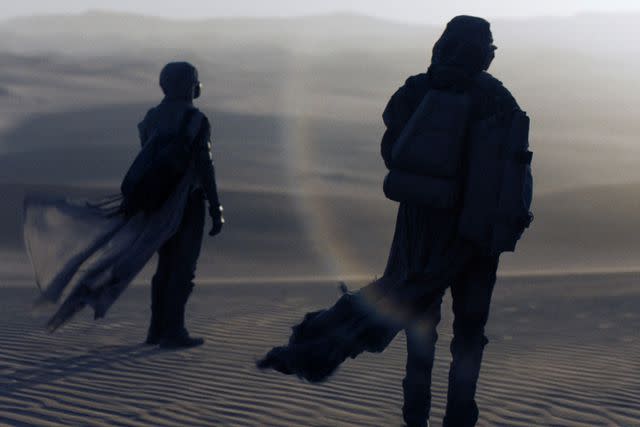“Dune” Choreographer Benjamin Millepied Explains How He Created the Desert Sandwalk (Exclusive)
- Oops!Something went wrong.Please try again later.
- Oops!Something went wrong.Please try again later.
'Black Swan' choreographer Benjamin Millepied breaks down the 'Dune' sandwalk in an interview with PEOPLE

Warner Bros.
Timothée Chalamet in Dune: Part TwoDune: Part Two is finally here — and so is a uniquely choreographed movement only found on the fictional planet Arrakis.
2021's Dune: Part One, the first installment in filmmaker Denis Villeneuve's adaptation of the 1965 science fiction novel by author Frank Herbert, introduced audiences to the grand scale of the Arrakis desert, its native inhabitants the Fremen (played by Zendaya and Javier Bardem, among others) and the planet's giant, monstrous sandworms.
In the movie, Timothée Chalamet's character Paul Atreides — and later, his mother Jessica (Rebecca Ferguson) — are shown learning about the sandwalk, which characters in the open desert use so as to not attract the deadly worms, who attack beings and objects that generate rhythmic movements across the planet's surface. To cross the desert safely, Paul and Jessica are shown making erratic steps and dragging their feet in a bizarre fashion to discourage patterned movement and stay alive.
Dune: Part Two further explores Paul's journey into the desert. While speaking with PEOPLE in April 2023 about his movie Carmen, choreographer and filmmaker Benjamin Millepied explained how he helped Villeneuve, 56, visualize the sandwalk, an integral part of life on Arrakis.
"It was to come up with a walk that didn't have rhythm," Millepied, 46, says of creating the sandwalk. "I created [the walk] in the sense so they would make beautiful shapes too. It's something that Denis was interested in."
Related: Dune: Part Two Review: Timothée Chalamet Is Back in a Sequel That's Even Better Than the Original

Everett
2021's Dune: Part OneMillepied explains that the purpose behind the choreography was "so the actors would be comfortable breaking the rhythm, basically."
Around the release of the first Dune movie in 2021, Villeneuve told Entertainment Weekly that he tasked Millepied with creating "a very simple way of walking the desert so that you will not trigger anything."
Never miss a story — sign up for PEOPLE's free daily newsletter to stay up-to-date on the best of what PEOPLE has to offer, from celebrity news to compelling human interest stories.
"It's something that we see just a little glimpse of in Part One, but it's a really beautiful design," he said at the time. "It's a way of walking in the desert that will not create a rhythm, because if you walk with a certain rhythm, the worms are attracted to that. So we designed a walk that emulates the sand and the sound of the desert. It's a genius idea from Frank Herbert that I wanted to make sure would be on the screen."

Courtesy Warner Bros. Pictures
Zendaya and Timothée Chalamet in Dune: Part TwoHerbert, the author behind the expansive Dune series, originally described the sandwalk as follows: "step...drag...drag...step...step...wait...drag...step," in one passage in the novel.
"I learned it well in advance, because it's Paul's responsibility to show Jessica in that moment, and it also has to be, in his Muad'Dib fashion, instinctual to him," Chalamet, 28, told EW about filming a scene in which he teaches Ferguson's character how to safely cross the desert. "But it was an even greater physical challenge on the day, just doing it again and again."
Dune: Part Two is in theaters now.
For more People news, make sure to sign up for our newsletter!
Read the original article on People.

